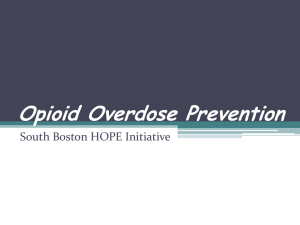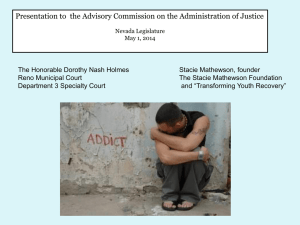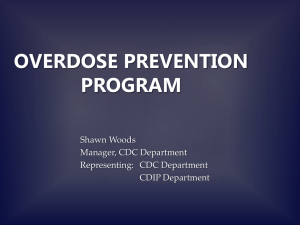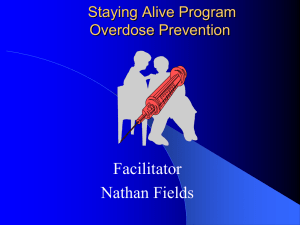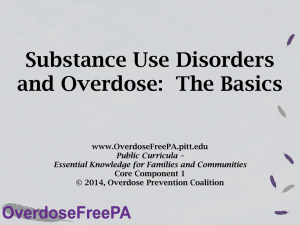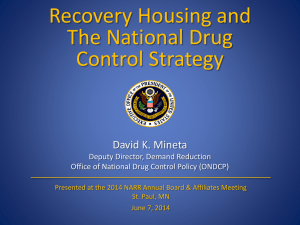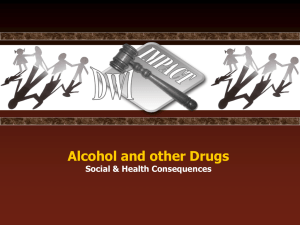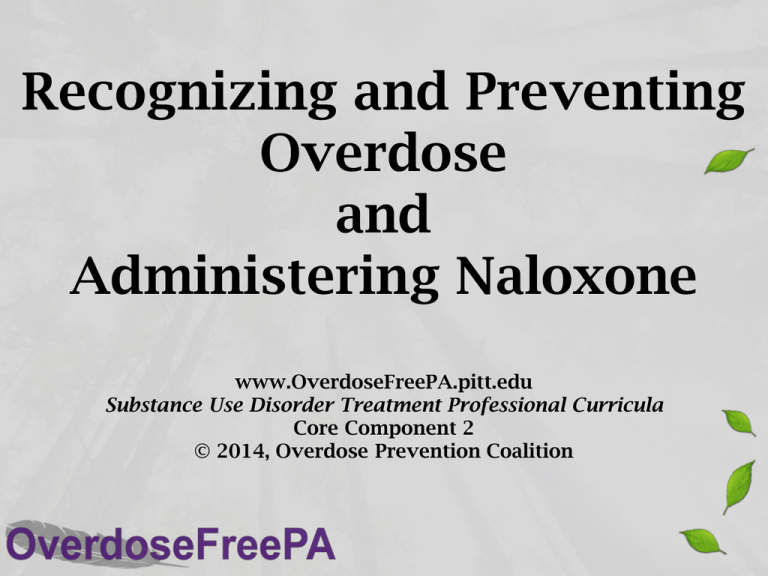
Recognizing and Preventing
Overdose
and
Administering Naloxone
www.OverdoseFreePA.pitt.edu
Substance Use Disorder Treatment Professional Curricula
Core Component 2
© 2014, Overdose Prevention Coalition
The OverdoseFreePA website is brought to you
by the Overdose Prevention Coalition, a
collaborative between:
The Pennsylvania Department of Drug and Alcohol Programs (DDAP)
The Single County Authorities (SCAs) of:
Allegheny County
Blair County
Bucks County
Butler County
Dauphin County
Delaware County
Westmoreland County
The Allegheny County Medical Examiner’s Office
The Program Evaluation Research Unit, University of Pittsburgh School of Pharmacy
The project is supported by a generous grant from the
Pennsylvania Commission on Crime and Delinquency.
Background Photo for Slide Set by Jason Pratt from Pittsburgh, PA (Trees and light)
[CC-BY-2.0 (http://creativecommons.org/licenses/by/2.0)], via Wikimedia Commons
SAMHSA National Survey
Past Month Nonmedical Use of Types of
Psychotherapeutic Drugs among Persons Aged 12 or
Older: 2002-2012
Substance Abuse and Mental Health Services Administration (SAMHSA), 2013
SAMHSA National Survey
Source Where Pain Relievers Were Obtained for Most Recent Nonmedical Use
among Past Year Users Aged 12 or Older: 2011-2012
SAMHSA, 2013
Overview of Substance
and Drug Use
Past-Year Initiates for Specific Illicit Drugs
Among Persons Age 12 or Older, 2008
SAMHSA, 2009
Overdose
• An overdose means having too much of
a drug or alcohol, or a mix of drugs
and/or alcohol for your body to safely
handle.
• Overdose can result in permanent brain
damage, permanent organ damage or
death.
• Overdose symptoms can look different
depending what kinds of drugs were
used.
DDAP, 2014; Centers for Disease Control and Prevention (CDC), 2012
Overdose (cont’d)
• Drug overdose was the leading cause of
injury death in the U.S. in 2010.
• Among people 25 to 64 years old, drug
overdose caused more deaths than motor
vehicle traffic crashes in 2010.
CDC, 2012
Overdose Deaths in
Pennsylvania
DRUG OVERDOSE DEATHS IN PENNSYLVANIA
Number of
PA
Rate per
Deaths
Population
1,000
Year
2011
1,909
12,742,886
15.4
2010
1,550
12,702,379
12.5
2008
1,522
12,448,279
12.6
2006
1,344
12,440,621
11.2
2004
1,278
12,406,292
10.6
2002
895
12,335,091
7.5
2000
896
12,281,054
7.4
1998
628
12,001,451
5.4
1996
630
12,056,112
5.4
1994
596
12,052,410
5.1
1992
449
11,995,405
3.8
1990
333
11,881,643
2.7
Based on Pennsylvania Department of Health data, overdose deaths
have been on the rise over the last two decades, with an increase in
the rate of death from 2.7 to 15.4 per thousand Pennsylvanians.
DDAP, 2014
It’s Good to Know …
Different drugs have different
overdose symptoms.
International Overdose Awareness Day (IOAD), 2014
Symptoms of Overdose
• Depending on the drug(s) involved, an
overdose victim can exhibit different
symptoms.
• It’s important to be able to recognize the
symptoms of overdose.
– Time is a factor.
– Prescription pills are involved in about 60% of
overdose deaths.
IOAD, 2014; Jones, 2013
Signs of Alcohol Overdose:
• Confusion
• Difficulty remaining conscious
• Slow breathing or gaps in breathing
• Clammy skin
• Vomiting
• Seizures
• Slow heart rate
• Dulled responses
• Extremely low body temperature
DDAP, 2014
Signs of Amphetamine/Other
Stimulant (“Speed”) Overdose:
• Amphetamine-induced psychosis
– (paranoia, hallucinations and/or delusions)
• Overheating
• Dehydration
• High blood pressure
• Seizures
DDAP, 2014
Signs of Opioid (Heroin,
Narcotic Pain Medication, Etc.)
or Depressant (Xanax, Valium,
Etc.) Overdose:
• Slow and shallow breathing
• Very sleepy and unable to talk
• Unconscious
• Blue lips or fingertips
• Snoring or gurgling sounds
DDAP, 2014
Overdose Prevention
• Recognize the symptoms of
an overdose.
• Call 911 immediately!
• Act quickly to administer
rescue breathing.
• Administer Naloxone
(Narcan®) if it’s available.
By Lviatour (Own work) [CC-BY-SA-3.0
(http://creativecommons.org/licenses/by-sa/3.0)], via
Wikimedia Commons
DDAP, 2014
Strategies for Reducing
Overdose Deaths
• Prescription Monitoring Programs:
• Reduce Diversion, not demonstrated to
reduce overdose.
• Concern about increase in heroin use.
• Methadone and Suboxone treatment: Very
effective
• Abstinence-based drug treatment:
• Risk of overdose increases when relapse
occurs.
Bell, 2012
Strategies for Reducing
Overdose Deaths (cont’d)
– Community Based Education: Risk Factors,
Identification of Symptoms, Effective
Response, including Rescue Breathing, Calling
911 and Naloxone Administration
– Naloxone Prescription Programs
– Physician Prescribing when prescribing opioids
for pain
Bell, 2012
About Naloxone
• Naloxone reverses opioid-related sedation
and respiratory depression = pure opioid
antagonist
– Not psychoactive, no abuse potential
– May cause withdrawal symptoms
• May be administered IM, IV, SC, IN
• Acts within 2 to 8 minutes
• Lasts 30 to 90 minutes, overdose may
return
• May be repeated
• Narcan® = naloxone
• naloxone ≠ Suboxone ≠ naltrexone
Walley, 2013
Intranasal Administration
Prefilled naloxone
ampule
Mucosal
Atomization Device
(MAD)
Luer-lock syringe
http://www.healthycommunitiesme.org/rxprevention.html
Pro
• 1st line for some local EMS
• RCTs: slower onset of
action but milder
withdrawal
• Acceptable to non-users
• No needle stick risk
• No disposal concerns
Con
• Not FDA approved
• No large RCT
• Assembly required, subject to
breakage
• High cost:
– $40-50+ per kit
Walley, 2013
Intranasal Administration
(cont’d)
Walley, 2013
When is Naloxone Prescribed?
1. Patient release after emergency medical care involving opioid
OD/intoxication
2. Suspected history of illicit or nonmedical opioid use
3. High-dose opioid prescription (> 50 mg of morphine
equivalence/day)
4. Any methadone prescription to opioid naïve patient
Any opioid prescription and …
a. smoking/COPD/emphysema/asthma or other respiratory
illness
b. renal dysfunction, hepatic disease
c. known or suspected concurrent alcohol use
d. concurrent benzodiazepine prescription
e. concurrent SSRI or TCA anti-depressant prescription
Powers, 2012
When is Naloxone Prescribed?
(cont’d)
5. Prisoner released from custody
6. Release from opioid detoxification or mandatory abstinence
program
7. Voluntary request from patient
8. Patients in methadone or buprenorphine detox/maintenance
(for addiction or pain)
9. Patient may have difficulty accessing emergency medical
services (distance, remoteness)
10. Other reasons?
Powers, 2012
The Prescription Opioid
Epidemic
• Deaths due to prescription opioid use
have more than tripled in the past ten
years across the U.S.
• Prescription opioids have been linked to a
significant increase in overdose deaths in
Pennsylvania.
CDC, 2014; Sapatkin, 2014
Overdose is Preventable
By Charlesjsharp (Own work) [CC-BY-SA-3.0
(http://creativecommons.org/licenses/by-sa/3.0)], via Wikimedia Commons
The best strategy
for preventing
overdose is to
address SUD or
pain management
issues
appropriately
before they lead to
overdose.
NIDA, 2014

